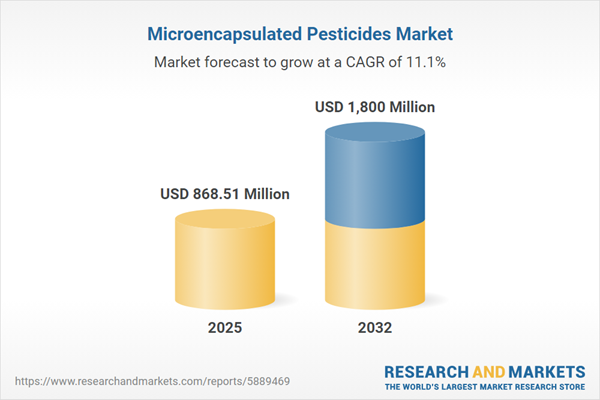Speak directly to the analyst to clarify any post sales queries you may have.
The microencapsulated pesticides market is adapting rapidly as organizations respond to evolving regulatory demands and a growing emphasis on sustainability. Senior leaders are focusing on agile strategies to manage compliance efficiently and capitalize on new business opportunities in this dynamic environment.
Market Snapshot: Microencapsulated Pesticides Market Growth
Between 2024 and 2025, the microencapsulated pesticides market is expected to expand from USD 780.13 million to USD 868.51 million, at an 11.08% CAGR. This positive outlook is fueled by technological advancements in pesticide delivery, stronger regulatory frameworks, and sustained investments in research, partnerships, and regional operations. Companies in this sector are intensifying efforts to strengthen supply chains while actively embedding sustainable technologies into their core processes. The result is a more competitive and future-ready landscape for industry participants.
Scope & Segmentation
- Active Ingredient Types: Consists of fungicides, insecticides, rodenticides, herbicides, and growth regulators widely utilized across varying agricultural and horticultural sectors for targeted pest management.
- Formulation Formats: Encompasses dustable powders, emulsifiable concentrates, granules, microcapsule suspensions, suspension concentrates, and wettable powders. These are applied based on crop needs and local environmental conditions to ensure efficacy and safety.
- Application Modes: Includes foliar spray, seed treatment, and soil application. These flexible approaches enable practitioners to address pest challenges in open fields, controlled greenhouses, and high-density urban spaces.
- Crop Types: Focuses on cereals, fruits, vegetables, oilseeds, and pulses, providing solutions that not only boost yields but also support food security and sustainable agriculture.
- End Uses: Caters to the requirements of agricultural producers, animal feed suppliers, turf care managers, and municipal vector control organizations, highlighting relevance that extends beyond traditional farming.
- Regional Coverage: Spans the Americas, EMEA, and Asia-Pacific. Strategies are tailored for each region’s unique regulatory environment and sourcing preferences, helping businesses remain compliant and resilient against market changes.
- Key Technologies: Integrates innovations such as biodegradable carriers, nanoengineered microcapsules, pH-responsive delivery systems, and digital agricultural tools to improve operational precision and transparency.
- Company Coverage: Profiles leading firms including Bayer AG, Syngenta International AG, Corteva Inc., BASF SE, FMC Corporation, ADAMA Agricultural Solutions Ltd., Sumitomo Chemical Co. Ltd., UPL Limited, Nufarm Limited, and Nichino Co. Ltd. Each plays a significant role in driving industry innovation and operational efficiency through advanced R&D and global partnerships.
Key Takeaways for Senior Decision-Makers
- Progress in controlled-release delivery is enhancing stewardship and aligning practices with regional sustainability standards.
- Adoption of digital agriculture platforms enables companies to demonstrate operational transparency, fostering trust in compliance-focused marketplaces.
- Collaboration between technology developers and operational managers expedites product introductions and streamlines regulatory adaptation.
- A diverse supplier base and flexible sourcing models help mitigate supply chain disruptions or unexpected policy shifts.
- Increased urban and municipal demand underlines the importance of environmentally responsible pest control in public health initiatives.
- Regional customization in product formulations allows businesses to meet complex regulatory and environmental requirements effectively.
Tariff Impact & Supply Chain Strategy
Recent U.S. tariff changes on encapsulation materials are prompting a shift toward domestic polymer sources and bio-based carriers. Organizations focused on microencapsulated pesticides are prioritizing localized procurement to reduce regulatory pressures and enhance predictability. Supplier agility and adaptable contracting structures are now central to future-proofing supply chains and maintaining continuous market access.
Methodology & Data Sources
This analysis employs a triangulated research methodology, integrating peer-reviewed publications, official regulatory data, and primary insights from industry stakeholders. Findings are further validated through pilot projects and case studies, ensuring relevance and reliability.
Why This Report Matters
- Delivers actionable insights that inform investment decisions by analyzing evolving regulatory and technology trends.
- Equips senior executives with the intelligence needed to manage compliance proactively and reduce operational risk.
- Supports organizations in upgrading supply chain and digital systems, improving resilience and flexibility across regional markets.
Conclusion
Adopting advanced technologies, cultivating cross-industry collaborations, and applying analytics are essential for achieving compliance and operational excellence in the microencapsulated pesticides market. This analysis positions leaders to make informed decisions in an accelerating regulatory landscape.
Additional Product Information:
- Purchase of this report includes 1 year online access with quarterly updates.
- This report can be updated on request. Please contact our Customer Experience team using the Ask a Question widget on our website.
Table of Contents
3. Executive Summary
4. Market Overview
7. Cumulative Impact of Artificial Intelligence 2025
Companies Mentioned
The companies profiled in this Microencapsulated Pesticides market report include:- Bayer AG
- Syngenta International AG
- Corteva, Inc.
- BASF SE
- FMC Corporation
- ADAMA Agricultural Solutions Ltd.
- Sumitomo Chemical Co., Ltd.
- UPL Limited
- Nufarm Limited
- Nichino Co., Ltd.
Table Information
| Report Attribute | Details |
|---|---|
| No. of Pages | 193 |
| Published | November 2025 |
| Forecast Period | 2025 - 2032 |
| Estimated Market Value ( USD | $ 868.51 Million |
| Forecasted Market Value ( USD | $ 1800 Million |
| Compound Annual Growth Rate | 11.0% |
| Regions Covered | Global |
| No. of Companies Mentioned | 11 |









